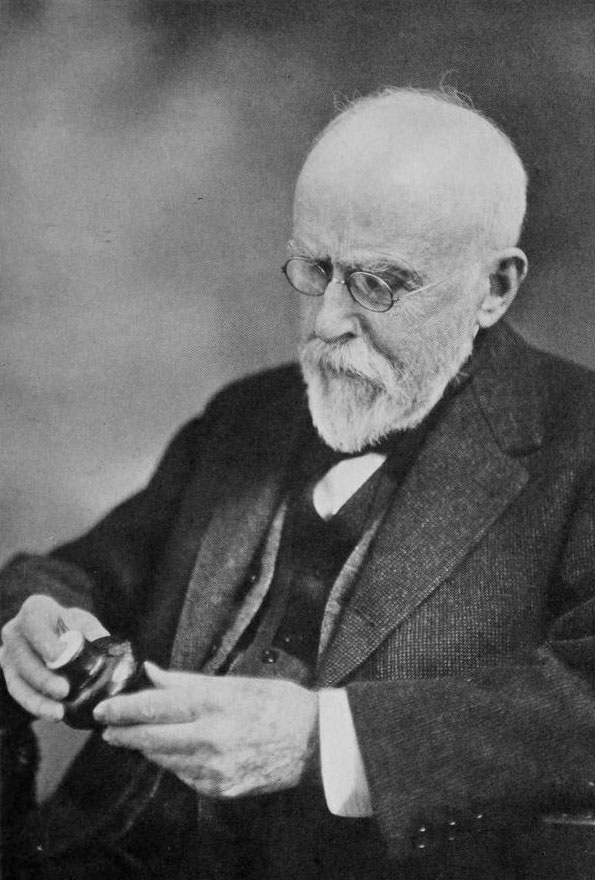
 |  |  |
| | Home | Cultural Exchange | Edward Morse |
FEATURE:Noh and International Cultural Exchange
7Morse – the Zoologist who Learned Noh Chanting
His excavation of the Shell Mounds of Omori opened up the field of Japanese archaeology

Professor Edward Sylvester Morse (1838-1925) was an American zoologist. In Japan, Morse’s name appears in history textbooks as the excavator of the Shell Mounds of Omori and he is known as a great man. Morse was born in Portland, Maine in 1838. While Morse did not go to college, he was noted for his collections of land snails, becoming a professor at Bowdoin College and a lecturer at Harvard University, and he was named secretary of the authoritative American Association for the Advancement of Science in 1872.
Morse arrived in Japan in June 1877. It is said that, having landed in Yokohama, he spotted the Omori shell-mounds from the window of a train bound for Shimbashi. Brought to Japan by his specialized interest in brachiopods, which he aimed to collect, Morse went on to be inaugurated as professor of the Department of Science at the Imperial University in Tokyo and made significant contributions to the development of academic research and education in Japan. His achievements in the archaeological excavation of the Omori Shell Mounds are particularly significant as they led to the inception of archaeology and anthropology in Japan. He also went to great lengths to welcome several fellow Americans to Tokyo Imperial University, including the physicist Thomas Corwin Mendenhall and the philosopher and art historian Ernest Francisco Fenollosa.
Morse’s investigations extended to Noh, the tea ceremony and other aspects of Japanese culture
Morse’s interest was aroused by the earthenware he found during the Omori excavation and he collected ceramics and folk artifacts across the length and breadth of Japan. He was clearly driven by both curiosity and a keen spirit of enquiry. His interest was not limited to objects, however, but extended to the culture of Japan and Noh became a part of his quest for further knowledge.
Morse traveled back and forth between Japan and the United States several times, but it is estimated that his studies of Noh chanting occurred during the final month or so of his last trip to Japan, a trip that lasted for less than a year that spanned June 1882 through February 1883. A magazine interview with Umewaka Minoru records that Morse began practicing Noh in January 1883.
Morse, who also took an interest in the tea ceremony, is believed to have enjoyed anything that offered a hands-on experience and, not satisfied with simply watching Noh, he approached Umewaka Minoru having heard that he was looking to give lessons in Noh chanting. Umewaka initially raised difficulties, citing the fact that no one had ever attempted to teach Noh chanting to a foreigner, but he was won over by Morse’s enthusiasm and agreed to give Morse lessons in person.
Learning Noh chanting from Umewaka Minoru, ushering in Fenollosa

An original sketch by Morse.
“Japan Day by Day”, Edward Sylvester Morse
And so, to the first day of Morse’s practice. Family members and disciples, along with neighbors who had learned of the event gathered on the other side of the fusuma (sliding doors) waiting in breathless suspense as the practice began. A Japanese person can work through the practice by repeating parrot-like the chants they are shown from the Book of Noh Chants, but for a foreigner unable to read the script, even this is impossible. When the elderly Umewaka asked Morse to tell him how they should proceed, Morse responded by asking him to try chanting for him anyway.
The elderly Umewaka chanted a few lines four or five times over; Morse made notes of the phonetic sounds using romanization, converting the upper and lower reaches to musical notes, which he recorded on manuscript paper, and even appending notation on tempo. Having chanted the lines over several times with Umewaka, he was then able to chant them alone. This was a cause of amazement not only to Umewaka but also to everyone who had gathered nearby to listen. Morse’s voice differed in quality, but Umewaka was impressed by the fidelity with which he reproduced the sound. By the time he returned to the United States, Morse had memorized five or six plays, including Kurama-Tengu, Funa-Benkei, Tamura and Hagoromo; Umewaka also recalls that the two men exchanged photographs in commemoration of their time together. Morse, too, wrote about and illustrated his experience practicing Noh chanting in his book “Japan Day by Day” (1917).
Having paved the way for Fenollosa, who went on to become a pioneer in Noh theatre research in the English-speaking world, to come to Japan, Morse also created the opportunity for him to study under Umewaka Minoru, thereby bolstering the study of Noh chanting. The Japanese people are deeply indebted to Professor Morse, not only for his work in the fields of archaeology and zoology, but also for his contributions to Noh theatre.